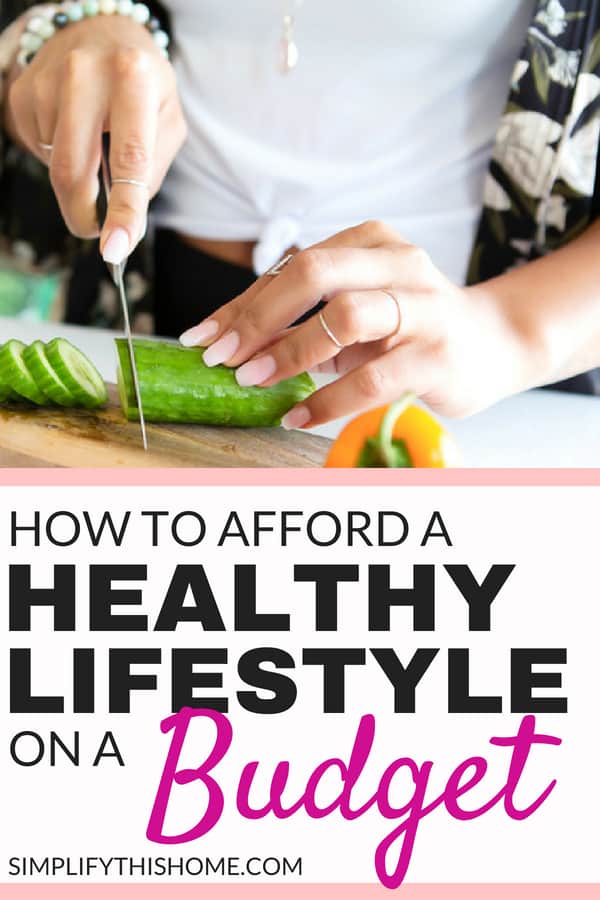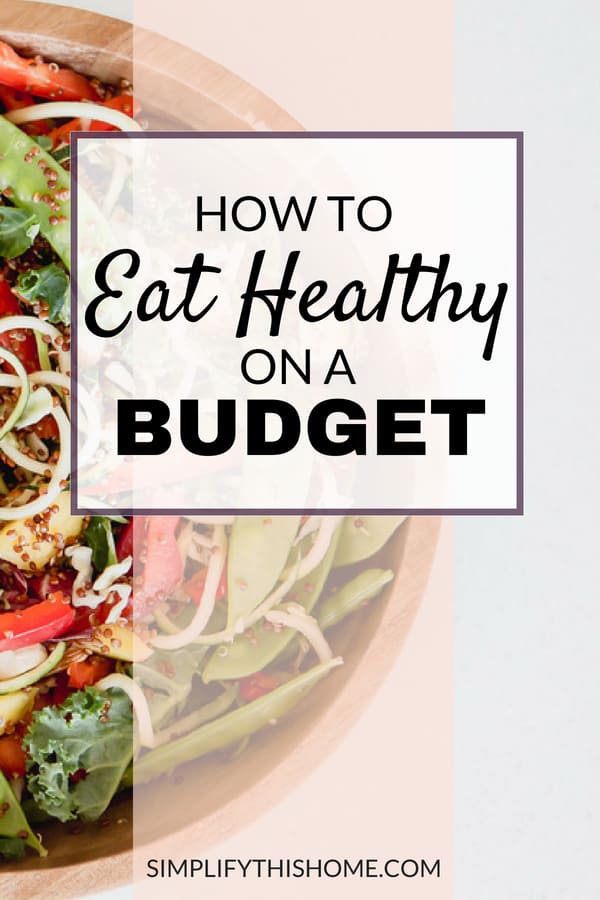How to Afford a Healthy Lifestyle on a Budget
Think your budget is too tight to eat healthy food? Think again! Here’s how you can afford a healthy lifestyle on a budget, even if you think healthy food is too expensive!

This post may contain affiliate links. See my full disclosure here.
“I can’t afford to eat healthy.” “It costs more to buy healthy food than junk food.” “I’ll make my health a priority when I can afford it.” “Healthy lifestyle on a budget? I think not.”
Have you ever said those things, either to yourself or out loud?
I’ve heard these excuses plenty of times, sometimes from my own mouth! But I think there’s a huge misconception surrounding healthy food options.
In fact, when Josh and I started eating a more plant-based diet, I was surprised to learn just how affordable healthy food can be!
Let me share with you what I’ve learned and how I get the biggest bang for my buck at the grocery store.
Related: 12 Healthy Habits You Can Start Today
How to Afford a Healthy Lifestyle on a Budget
Can you afford to adopt a healthy lifestyle on a budget?
I asked myself the same thing when we first embarked on our plant-based journey. I mean, the general consensus is that healthy food is more expensive than unhealthy food, right?
But do you know what I found? We actually spend less money eating this way than we ever did on the Standard American Diet!
So I’m here to counter all those excuses I wrote at the beginning of this post. You can most definitely afford a healthy lifestyle on a budget. You just have to know how to do it the right way.
Here are some tips that have worked fabulously for us:
Make Healthy Foods Your Priority
You have to prioritize healthy foods. Choose to purchase quality, fresh produce instead of unhealthy, prepackaged foods. Trust me, it will cost way too much if you try to buy both healthy foods and Standard American Diet (SAD, for short) staples.
Rather, put the money you’d normally spend on junk toward healthy foods. Your wallet (and body!) will thank you.
Also, I quickly discovered that produce is actually pretty cheap compared to SAD staples. Meat and dairy products were always the most expensive items on my grocery list.
When you stop buying meat, dairy products, and prepackaged foods, you free up a large part of your budget to buy fresh produce and other healthy plant foods.
Related: Cheap Healthy Food: Affordable Options for the Savvy Budgeter
Organic or Non-Organic?
Determine what’s important to you as far as organic vs. non-organic goes. Organic is usually more expensive, although I have seen organic blueberries for less than their regular counterparts during an Aldi special.
Some people choose all organic, others choose no organic, and still others choose a mix of the two.
For me, I choose a mix of the two. I buy organic if it’s available and makes sense.
The Environmental Working Group publishes updated lists of foods you should buy organic and which foods are okay to buy non-organic. The Dirty Dozen is a list of foods that have higher pesticide residues. If you can afford it, it’s best to buy these foods organic. The Clean Fifteen is a list of foods that have lower pesticide residues. These are okay to buy non-organic.
You can read more about the Dirty Dozen and Clean Fifteen here.
Do what makes sense for you and your budget. If you can’t afford any organic produce, that’s okay! You’re still getting better quality nutrition than if you were buying prepackaged SAD meals.
As your grocery budget increases, incorporate more organic produce as you see fit.
Shop Smart
If you have a strict $100 per person per month budget (which seems to be the standard based on what I’ve seen from other frugal bloggers), then you definitely want to skip Whole Foods Market.
Instead, choose less expensive grocery stores such as Aldi and Lidl.
We could not afford to eat a plant-based diet at any other grocery store. And the best part is that Aldi has lots of organic foods that I think are very reasonably priced!
While you’re shopping at Aldi or Lidl, choose produce that is in-season. You’ll pay less than you would for out-of-season produce.
Also, utilize sales! When I make my meal plan and grocery list, I like to check Aldi’s sale page on their website to see what produce is on sale that week. Often, in-season produce is what they list on their produce picks of the week.
But Shop at Home First
Before you head to Aldi or Lidl, create a meal plan around the food you already have at home. I call this “shopping the kitchen.” You save money by cooking things you already have on hand, and you’re less likely to waste food.
It’s astonishing how much food we waste here in America. I’m guilty of it too, but I just imagine throwing a $1 or $5 bill in the garbage every time I toss out bad produce, and that makes me want to use up that box of spinach from last week!
Stick To A Meal Plan
Meal planning is the secret sauce to being able to afford a healthy lifestyle on a budget. Meal planning helps you avoid unnecessary purchases because you know exactly what food you need for this week’s meals. No more, no less.
It does take a little bit of discipline to follow your shopping list without tossing additional items in your shopping cart, but those impulse purchases add up quickly! If you know you have a limited food budget, resist the urge to splurge on things that you don’t really need.
Carefully Weigh Your Options
Weigh the costs of a healthy lifestyle. My mom always likes to say that you’ll either pay at the grocery store or at the doctor.
You can spend your money on quality, plant-based foods at the grocery store and potentially avoid and/or correct your health problems. Or you can pay for medications, doctor visits, surgeries, and more while eating SAD staples.
Sometimes it’s helpful to look at it this way: Can you afford to not adopt a healthy lifestyle?
You’ll often pay more in medical costs than you would at the grocery store, especially when you look at it over an entire lifetime. It’s far better to adopt a healthy lifestyle earlier in life so you can prevent some serious health problems later, even if it costs you a little bit more than what you currently spend.
But remember, it actually costs us less to eat healthfully, so it’s a double win!
Wrapping it Up
So those are my best tips for affording a healthy lifestyle on a budget!
All you have to do is make healthy foods your priority, determine how much organic food you can/want to afford, shop at less expensive grocery stores, create a meal plan around the food you already have at home, and consider the long-term costs of not purchasing healthy food.
Trust me, a healthy lifestyle is way more affordable than you think. And even if you find that it’s a little more expensive than what you normally spend on groceries, I can assure you that the health benefits far outweigh the costs!
Other Posts You May Enjoy
- What is a Whole Food, Plant-based Diet?
- Plant-based Shopping List: What to Buy When You Follow a Plant-based Diet
- 15 Plant-based Recipes You Need to Try
- 3 Simple Ways to Live a Healthy Lifestyle
- The Best At-Home Workout Programs for Women Who Hate the Gym
- How to Win with Your New Healthy Lifestyle
Do you have any tips for living a healthy lifestyle on a budget? I’d love to hear about it in the comments!

Want to remember this? Save it to your favorite Pinterest board by clicking the images below!



